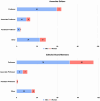Unveiling disparity: A call to action for gender diversity in anatomy journal editorial teams
- PMID: 40231698
- PMCID: PMC12135460
- DOI: 10.1002/ase.70034
Unveiling disparity: A call to action for gender diversity in anatomy journal editorial teams
Abstract
This study aimed to determine the representation of women on the editorial teams of anatomy journals and to investigate the possible reasons for gender differences. The anatomy journals listed in the Web of Science Master Journal List and on the International Federations of Associations of Anatomy website were evaluated. The number, gender, and academic titles of editors-in-chief, associate editors, and editorial board members were recorded, along with the journals' continents, association/society memberships, quartiles, and impact factors. A total of 36 journals were analyzed. Ten out of 49 (20.41%) editors-in-chief, 71 out of 347 (20.46%) associate editors, and 285 out of 1065 (26.76%) of the editorial board members were women. The number of women on editorial teams was not related to the continent of the journal, any association/society, or quartile/impact values (p > 0.05). Asian journals had a significantly higher proportion of men associate editors compared to the higher proportion of women associate editors among North American journals (p < 0.05). There were 6 (16.67%) journals that provided information on the gender of the editorial team, 13 (36.11%) that provided academic titles, and 5 (13.89%) that published photographs. Women were rarely represented in all positions on the editorial teams of anatomical journals. The anatomical editorial community has an opportunity to make improvements toward gender equality by considering policies and strategies to overcome gender disparities.
Keywords: diversity; equity; gender equity; inclusion; women anatomists; women editors; women in anatomy; women in science.
© 2025 The Author(s). Anatomical Sciences Education published by Wiley Periodicals LLC on behalf of American Association for Anatomy.
Conflict of interest statement
The authors have no conflicts of interest to declare.
Figures

Similar articles
-
Gender distribution in psychiatry journals' editorial boards worldwide.Compr Psychiatry. 2019 Oct;94:152119. doi: 10.1016/j.comppsych.2019.152119. Epub 2019 Aug 21. Compr Psychiatry. 2019. PMID: 31473553
-
Gender distribution among surgical journals' editorial boards: Empowering women surgeon scientists.Surgery. 2021 Jun;169(6):1346-1351. doi: 10.1016/j.surg.2020.12.026. Epub 2021 Jan 23. Surgery. 2021. PMID: 33494948
-
Gender imbalance in critical care medicine journals.Anaesth Crit Care Pain Med. 2025 May;44(3):101504. doi: 10.1016/j.accpm.2025.101504. Epub 2025 Mar 12. Anaesth Crit Care Pain Med. 2025. PMID: 40086731
-
Representation of women as editors in dermatology journals: A comprehensive review.Int J Womens Dermatol. 2019 Sep 12;6(1):20-24. doi: 10.1016/j.ijwd.2019.09.002. eCollection 2020 Jan. Int J Womens Dermatol. 2019. PMID: 32025556 Free PMC article. Review.
-
The proportion of male and female editors in women's health journals: A critical analysis and review of the sex gap.Int J Womens Dermatol. 2019 Dec 27;6(1):7-12. doi: 10.1016/j.ijwd.2019.11.005. eCollection 2020 Jan. Int J Womens Dermatol. 2019. PMID: 32025554 Free PMC article. Review.
References
-
- Koyuncu Şahin M, Esen Çoban A, Korkmaz A. Toplumsal Ci̇nsi̇yet Eşi̇tli̇ği̇ Ve Türk Eği̇tim Si̇stemi̇ndeki̇ Yeri̇: Okul Öncesi̇ Öğretmen Adaylarinin Gözünden. J Int Sci Res. 2018;3:735–752. 10.21733/ibad.457232 - DOI
-
- Aliki F, Piagkou M, Katerina V. Women in anatomy in Greece: scientific staff and directors in the anatomy departments. Rev Argent Anat Clin. 2023;15:36–37. 10.31051/1852.8023.v15.n1.40529 - DOI
MeSH terms
LinkOut - more resources
Full Text Sources
Medical
Miscellaneous

